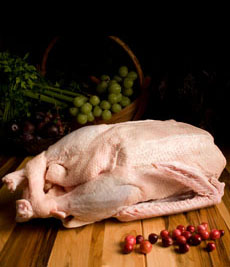
Ready to roast! Photo courtesy D’Artagnan. |
|
Preparation
1. PAT the goose dry inside and out, using paper towels. Set it in a roasting pan and refrigerate, uncovered overnight. The next day…
2. REMOVE the goose from the refrigerator and bring to room temperature (about 1 hour). If the bird is still moist, pat it dry inside and out with paper towels.
3. PREHEAT the oven to 350°F. In a large roasting pan, scatter the carrots, celery and onions. Generously season the inside the inside of the goose with salt and pepper and stuff it with the apple, orange, quartered onion and thyme.
4. PRICK the skin of the goose all over. Season the outside of the bird with salt and pepper. Truss it and set it directly on top of the vegetables. Add 1/2 inch of hot water to the pan. Transfer the roasting pan to the oven and roast the goose until an instant-read thermometer interred in the thigh reads 165° to 180° and the juices run clear, 2 1/2 to 3 hours.
|
5. REMOVE the fat from the pan with a baster as necessary and reserve the fat for the braised cabbage (otherwise, store in the fridge for future use). If the skin is not crisp, increase the oven temperature to 375°F and roast for 10 minutes more. Transfer the goose to ae cutting board, cover loosely with foil and let rest for 30 minutes. Meanwhile…
6. MAKE the sauce: In a large casserole, heat the oil until smoking. Add the giblets, neck and wing tips and cook over medium-high heat, stirring occasionally, until browned all over, 8 to 10 minutes. Using a slotted spoon, transfer the giblets, neck and wing tips to a bowl. Pour off most of the fat in the pot.
7. ADD the onions, carrots, celery and garlic to the pot and cook, stirring frequently, until browned, about 8 minutes. Stir in the tomato paste. Add the wine and ice cubes and cook, scraping up the browned bits stuck to the bottom, until almost all the liquid has evaporated, about 5 minutes. Return the giblets, neck and wing tips to the pot and add enough water to cover the ingredients by 2 inches. Add the thyme and rosemary and bring to a boil, then reduce the heat to medium-low and cook for 1 hour.
8. STRAIN the stock into a large bowl, discard the solids. Return the stock to the pot and boil over high heat until it coats the back of a spoon, about 10 minutes.
9. DISCARD the apple, orange, onion and thyme in the goose’s cavity. Carve the goose and serve with the sauce.
THE HISTORY OF CHRISTMAS GOOSE
While modern American families tend to have a turkey, ham or roast beef for Christmas dinner, goose remains the traditional Christmas meat of choice for many Europeans.
Goose has been a feast bird as far back as ancient Egypt. According to FoodTimeline.org, before modern animal husbandry, geese were at the ideal stage to be eaten twice a year. The first time was when they were young, in the early summer; and the second when they were at their fattest and ripest, toward the end of the year.
Before Christianity took hold, Northern Europeans feasted on goose to give thanks to Odin and Thor for the harvest. By the Middle Ages, geese were the feast food at Michaelmas, which fell on the winter solstice (which occurs on December 21, 22 or 23, depending on the year), to honor the end of the harvest. It was just a short step to Christmas.
|




